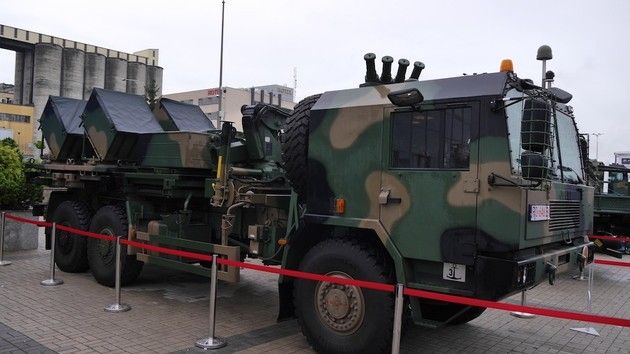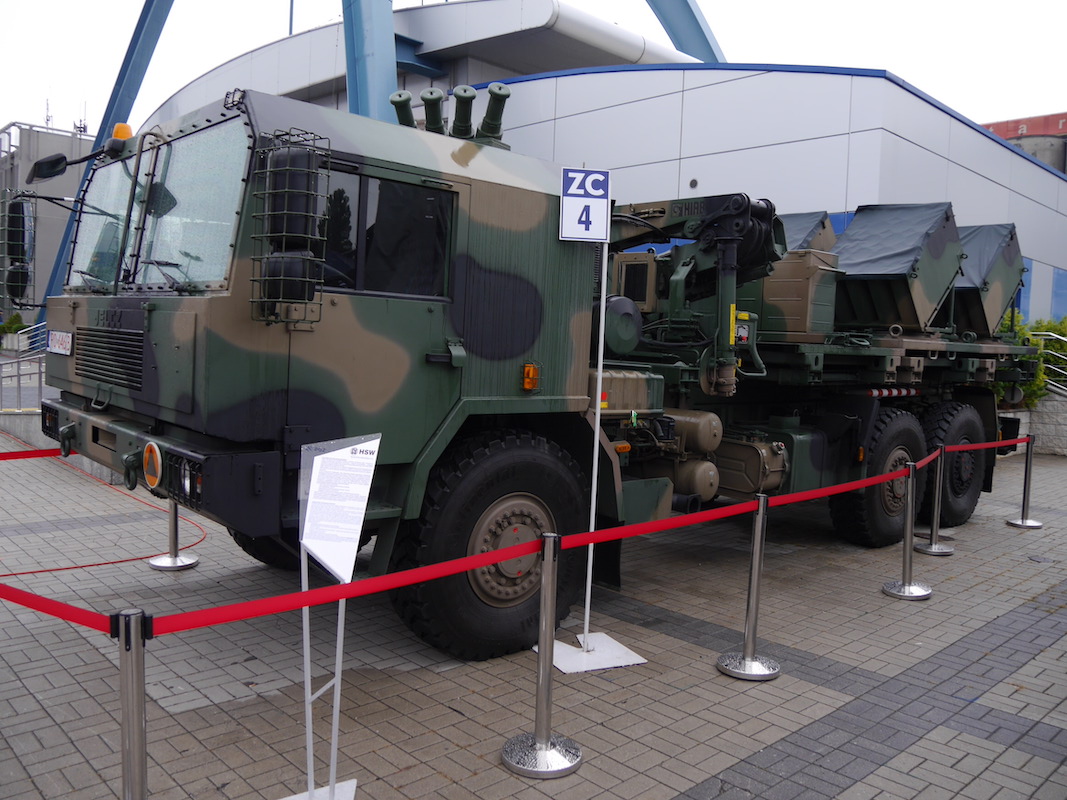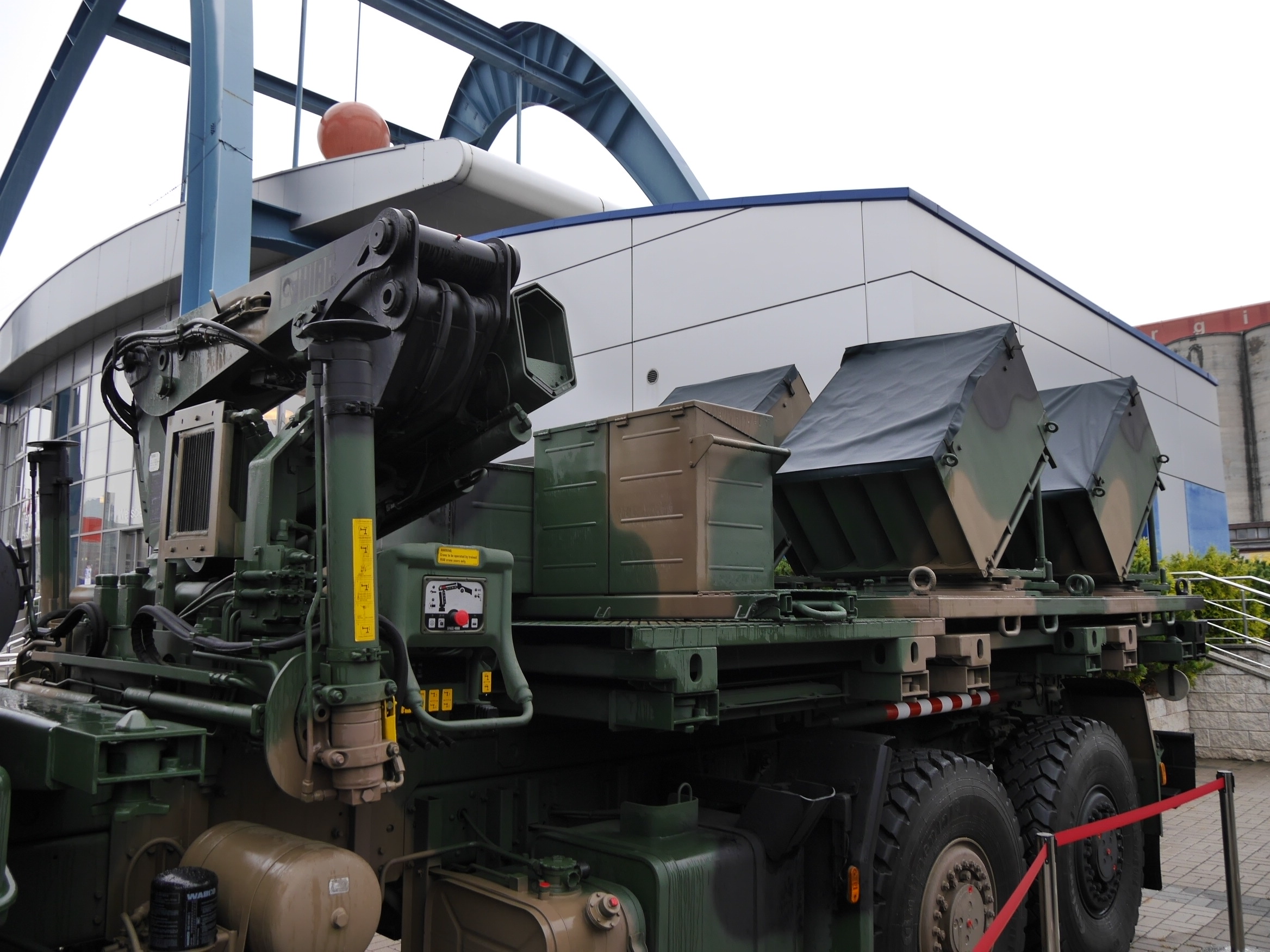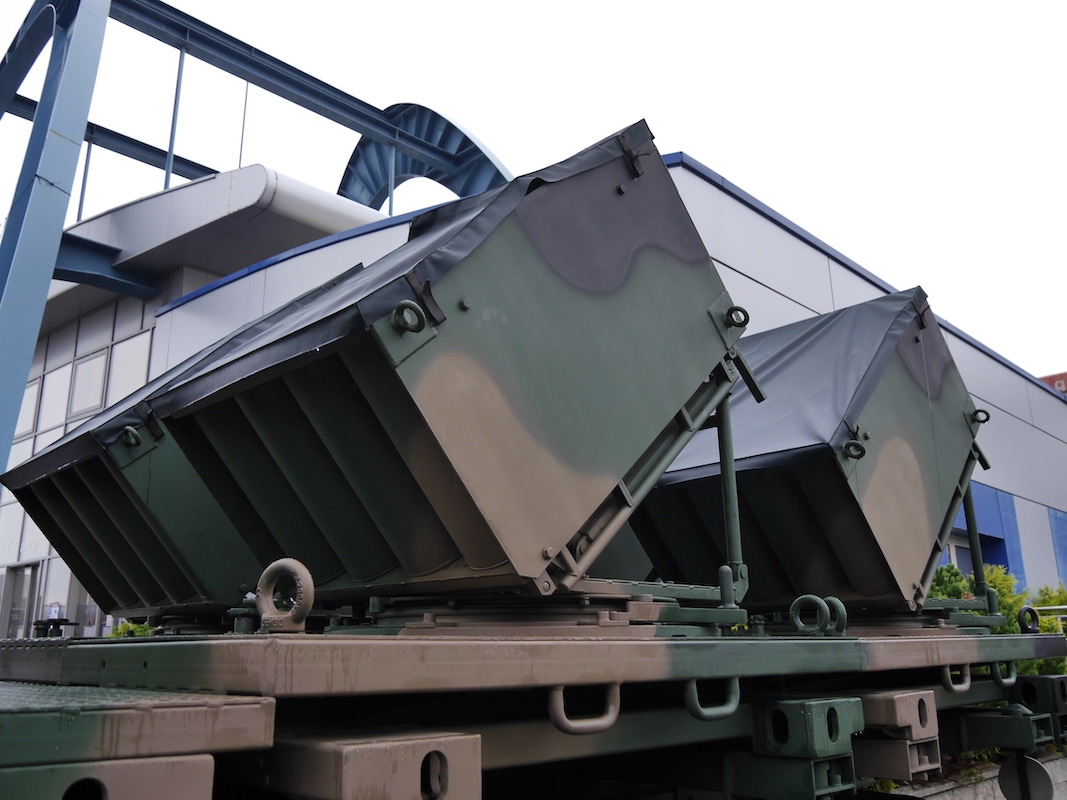Strona główna
MSPO 2019: Baobab Scattered Minelaying System - Project Progress [Analysis]

Demonstration of the Baobab Scattered Minelaying System during the MSPO event in Kielce is a good occasion to have a look at this solution, an under-appreciated support measure for the combat units.
Recent decision made by the Polish MoD may create a chance to finalize the Baobab project. The probability has been reinforced by an agreement signed on 28th December 2019, concerning the Design and Development stage implementation of the Baobab-K Scattered Minelaying Vehicle R&D project. The work involves a consortium led by HSW S.A. and with the following entities acting as its members: Jelcz sp. z o. o., BZE BELMA S.A. and Military Institute of Technical Engineering. The whole project is an extension of R&D effort of 2014, within which the Consortium, with a slightly different composition, defined the design assumptions, in line with the requirements defined by the MoD.
This has been the fourth attempt made to finalize this project. All three previous procedures that began in 2015 (twice) and in 2017 were cancelled. In the last project the MoD accepted an offer with a pricetag of PLN 19.9 million zlotys. The agreement signed on 28th December 2018 gives the consortium 36 months, from the date of conclusion, to accomplish the task of creating a model of the vehicle, which is to be followed by prototyping and then tactical and technical assumptions would be verified. Then, the consortium needs to submit technical documentation of the product to the MoD, making it possible to begin series manufacturing. The potential scale of production remains unknown, as for now.

Poland has a long-running history of working on scattered minelaying systems that are currently going through a renaissance. Kroton system was the first concept of such system, inspired by solutions such as Volcano, Shielder, UMZ or Minotaur. OBRUM Gliwice company was the entity that made the first attempt to develop a system of this class that was born in the aforesaid form. The project assumed that eight scattered mine delivery system launchers would be installed on the SPG-1 tracked chassis developed in the 1980s. The chassis featured eight mine launchers, allowing for delivering MN121 anti-personnel mines or MN123 anti-tank mines with a shaped charge. This minelayer, configured like that, weighed 22 tonnes and was able to carry payload of 10 tonnes. It was to be able to set a minefield consisting of 800 mines.
It was planned that the vehicle would also be fitted with smoke grenade launchers, Deugra fire extinguishing system, TNPO-168W daytime observation system or PNK-72 Radomka day/night observation system, UWS-200 filtering/A/C system with capability to generate overpressure, ASS-1 Tafios or GO-27 chemical contamination detector, RRC-9500 radio and containers that could be used to carry extra equipment. This concept, however, was abandoned. It only became a project offered by OBRUM Gliwice.
Meanwhile, HSW S.A., working with WITI, started to develop its own Scattered Minelaying Carrier concept also known under the name ISM Kroton. It was based on the popular MT-LB tracked platform. For the sake of developing this product, the chassis received one more pair of supporting wheels (7 instead of 6), and thus its total length has been extended to almost 7.5 meters. Four launcher blocks housing 400 mines in total have been installed on that platform. The vehicle was also fitted with a .50-cal. machine gun, filtering/A/C/heating system, communications suite and manual/automatic fire extinguishing system. It also featured daytime/night observation sight, roentgenometering signalizer and contamination neutralization kit.
Two-man crew may create a minefield with dimensions of 60×600 meters in less than 15 minutes. The mines may be launched to the sides (at distances between 30 and 90 meters) and to the back of the vehicle. A cassette containing 5 mines weighs 23 kilograms. It takes 40 minutes to recover the capability through replenishment of the mines in the launchers. TMN ISN Kroton’s operational weight is 15.8 tonnes, thus, to provide the vehicle with proper performance and offroad capabilities it is enough to use a typical YaMZ engine producing 220 kW of power output and coupled with a conventional mechanical gearbox.
Kroton prototype sparked a lot of interest during the MSPO event as early as in 2003. The minelaying system designed in this manner received the MoD’s approval. This was shown in the 128/OTWL/2005 document published on 4th January 2005, concerning introduction of Kroton into the inventory of the Polish military’s engineering units. HSW S.A. has delivered several examples of thew TMN ISM Kroton platform to the military - they are still in operation with the MN123 mines delivered in small quantities by the Bydgoszcz-based Belma company.
Success of the TMN ISM Kroton programme became a source of inspiration to place the mine launcher on another, wheeled carrier. Firstly, according to the directions provided by the MoD, Star 1466 vehicle was employed in that role. This platform was then integrated with elements of the minelaying platform originally designed for Kroton. The vehicle in this configuration with four minelayer blocks was manufactured at HSW and officially rolled out in the early 2007. Considering the fact that production of military vehicles was suspended in Starachowice, the platform had to be changed for the programme to continue.
HSW received a signal that India could be interested in procuring the system, via the BUMAR-ŁABĘDY facility. The interest was quite intense, as the Indian side even delivered its own Tatra platform via the BEML company. The Indian MoD was and still is using the said vehicle to a great extent. The events mentioned above were taking place when efforts were being made in India, aimed at acquisition of the Krab sph. Unfortunately, the agreement was not concluded. HSW, not willing to resign from a programme with a quite high potential received an approval from the Polish military to create a wheeled scattered mine delivery system. Jelcz vehicles were to be used in a role of the base platform.
For the sake of clarity, one should note that the factory was in a bad shape economically as well, after the Jelcz vehicle manufacturing facility went into bankruptcy, and after the whole automotive tycoon was decomposed. The facility, where only a small Jelcz-Komponenty company remained active, received assistance from HSW S.A. The company received an order for the modernized BM-21M multiple rocket launchers. In that way, WR-40 Langusta system was created.
Earlier on the MoD had been planning to modernize the BM-21 platform using the Star 1466 vehicle - and HSW even created a prototype of a variant as such, premiering it at the 2005 edition of the MSPO event. For the reasons not exclusively identical but similar to the ones applicable to the wheeled Kroton platform the programme was not successful. This created circumstances in which the WR-40 Langusta system was born based on the successful Jelcz P662.D350 platform with armoured cabin accommodating the six-man launcher crew. WR40 prototype was presented in 2006, in Kielce.
The work undertaken between 2005 and 2006, concerning a new platform for the scattered mine delivery system on wheels had two speeds and two directions. The first one assumed that six mine delivery launchers would be placed on the Jelcz P.624D platform. These launchers could accommodate 600 MN123 mines in total. The minelayer prototype that was derived from the “Indian” developments was presented at the MSPO 2007 exhibition. The vehicle was fitted with HIAB loading system as well. Similarly as in case of Kroton, the launcher blocks were being deployed and set up manually.
Development of the PMN vehicle proper, also known as Baobab, began in 2008. When compared to the that had been showcased a year before, major changes were introduced. Above all, the platform was changed to the Jelcz P.662.35G34 vehicle belonging to the same family as the carrier in the WR40 Langusta system. However, the new vehicle has an armoured cabin that can accommodate two persons. HSW immediately proposed Baobab in two independent variants with 4 or 6 mine delivery modules for delivery of 400 to 600 MN123 mines with immediate or delayed fuses.
In the first variant, time required to deliver mines to create a barrier does not exceed 15 minutes. It takes 20 minutes to load the mines. Times applicable to the second variant are defined, correspondingly, as 22 and 30 minutes. With full load of mines, the platform weighs, as a whole, 5.5 or 6.7 tonnes, respectively. The vehicle features a lot of extra equipment. The communication systems (internal and external) include FONET and FRC 9311AP VHF radio. Furthermore, the system also features a modern computer controlling the mine delivery process, that also allows the crew to conduct mine delivery in an automated manner - trajectories and density of the minefield are automatically maintained. The vehicle also uses a GPS device with an odometer and visualization terminal with a digital map display. A report concerning the mine delivery process can then be sent up the command chain. Furthermore, the platform also features mine container testing system and 8 smoke grenade launchers for self-protection.
The prototype configured in that manner was ready for further operational use at the beginning of 2010. At the same time, the MoD was still refining the concept of the system. Decision was made to select the six-module version and to equip the platform with a self-loading system.
The platform, according to the requirements defined, was to be fitted with an ICT system that would make it possible to control the mine-laying process in manual and automatic mode (allowing the user to automatically set up the mine platform between combat and transport setting and the launchers themselves - here, at a user-defined angle - all to match the computed launch solutions), with visualization of the minefield on a digital map, with an option of automatic reporting (via the UHF) radio, referring to the created minefield and its parameters - these were to be transferred up the command chain. Furthermore, the commander terminal may transmit and receive data from the command chain, with regards to the minelaying mission, involving a minefield of specific parameters. Both the onboard computer, as well as the commander terminal are capable of developing minelaying solutions now, to obtain proper minefield parameters. In the previous variant, only the computer was capable of doing that. The Ordering Party also decided to install the Obra laser warning receiver system on the PMN platform.

All of the emerging circumstances created a necessity to change the vehicle concept, and to transfer it to a heavier 8×8 platform that could accommodate system that would be so expansive. HSW S.A. has not disclosed whether any of the known 882.53 or 882.43 platforms would be used, derived from the AWA and WA ammunition carriers used in Rak and Regina modules or Langusta II launcher. The company could just as well develop an entirely new solution, just to accommodate the Baobab-K system. No information remains available when it comes to use of the design solutions we could have witnessed in the armoured cabins manufactured so far.
The scale of demand concerning the Baobab-K vehicle is unknown. So far, the rumours suggested that the Polish military would need several vehicles. However, that data is long overdue. Back when it was current, the agenda did not include Territorial Defence Forces (one of the main users of the system in the future) or the new mechanized division that is being formed now. It is probable that around 50 vehicles could be acquired - this is what the unofficial information suggests. The vehicle is also promoted on the export markets - in its target and in the less advanced variant presented in Kielce this year.

There is one thing that is certain. If a decision has been made to name the system Baobab-K, then time will come for Baobab-G tracked variant to be developed as well. Most probably, the tracked carrier would accommodate solutions developed over the course of work on the Baobab-K vehicle. Platform as such, dedicated for heavy units, could replace the TMN Kroton system. Will it be based on the K9 Krab howitzer platform, or on the Borsuk IFV? It’s definitely too early to tell. The fact is that the development cycle may be brought to a closure. The scattered mine delivery system that initially was to be based on a tracked platform is to go through a renaissance in a wheeled form to ultimately reach the tracked form in the end.
Jerzy Reszczyński
